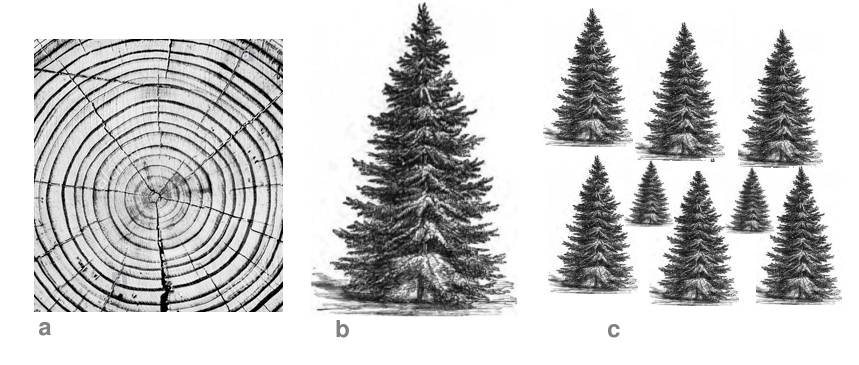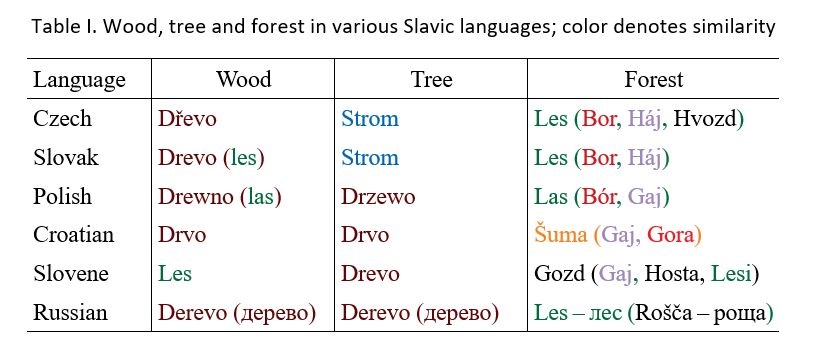
January 7, 2026

Pre-human and human societies developed languages to be able to communicate, which was especially needed if communities reached more than 150-200 individuals (Barrett et al. 2002). Development of a language was driven by certain requirements on its function. One of the functions of language is to “name” things, which is now called referential function according to Jakobson’s theory (Jakobson 1960). This function enables easier communication over casual things and phenomena by an identification of their “essence”. The naming of things sets a unique “identifier” in particular contexts, so, for instance, homonyms can be distinguished. In this text, we will focus on the origin and certain evolutionary path of the word “wood” since it is a material that humankind has been using since the very beginning. At the same time, it is the material that gives people a chance to live more environmentally and sustainably today and, perhaps, also in the future. One very-likely-to-have-happened legend says that the first bridge built was a tree that fell over a river. We could dare to assume that when this happened there was no word for “bridge” at that time, so the first “bridge” could have been called “wood” because there was no other identifier for this bridge … but, let us start from the beginning.
First, let’s have a look at the word wood in the English language and then extend our observation to several Slavic languages to find similarities between them. Similarity between English and Slavic languages should appear since both language families originated from Proto-Indo-European language (PIE).
It seems that the oldest ancestor of the word wood that can be found is *widhu-[i] (PIE), meaning “tree” and “wood”. The word *widhu– then stepped into the Proto-Germanic[ii] (PG) language as *widu (in Old High German[iii] it was witu), followed by the Old English word widu with the multiple meanings of tree, trees collectively, forest and the substance of which trees are made. Widu then transformed into the Old English word wudu and, finally, to the contemporary wood.
If we neglect arguments against using reconstructed languages such as PIE and PG, we notice quite a gradual development of the word wood, especially in a phonetic perspective – readers are now asked to pronounce all historical stages of wood aloud from beginning to current word form. More importantly, we notice that the word wood had several meanings as it was evolving: (i) material itself, (ii) living organism – tree and (iii) tree society – forest.

Figure 1. Wood as material (a), single living organism – tree (b), group of organisms – forest (c)
This means that the word wood had (and still has) a strong homonymous character, especially when compared to other and younger-in-use materials such as steel and concrete. It has its logic because of historical limitations of the language and the fact that people have been meeting wood daily in various shapes and at different conditions for thousands of years (in the forest, in construction, as tools, etc.), so a single word was enough to “identify” the particular objects in various contexts. The fact that the word wood had multiple meanings is important for the next point because it still occurs in certain contemporary Slavic languages. The comparison of words wood, tree and forest in several contemporary Slavic languages is shown in Table I.

Table I shows that many Slavic languages use words of the same root for the same and also various objects. For instance, the word wood is similar for most of the Slavic languages shown to describe material itself (except in Slovene), but the same word root in many of them also represents the living organism – a tree (except Czech and Slovak). Further, we see that for the society of trees – forest – all shown Slavic languages developed a different word than wood to identify it. However, it is hard to say if the word wood in Slavic languages is older than the word forest, i.e., we don’t know what people named and identified first – whether a material itself or group of trees. On the contrary, it seems that etymologically the word wood is much older than the word forest in the English language, so one could claim why it would be otherwise in other Indo-European languages.
Conclusions
All languages are slowly becoming more complex and growing in terms of the cumulative number of words they possess; they keep words no longer used frequently and absorb new ones. One reason for the growing complexity of language is increased sensitivity, especially from Jakobson’s referential function point of view. Increased sensitivity gives new and more precise names to surrounding things and phenomena and makes our communication more precise and, perhaps, easier. Science is one of the biggest factors driving such an increase in our sensitivity because it “unveils” the essence/nature of studied objects. If we look at how science defines wood, we learn that scientific precision might be also be overwhelming; it can make communication more difficult because the scientific term might be too long for both casual and scientific use. Scientifically, wood may be defined as a natural hygroscopic, heterogeneous, anisotropic, visco-elasto-plastic and composite biopolymer.
Fortunately, such a long and accurate identifier cannot replace “wood” (in any language) for the sake of precision because language is not only about precision but also about certain “aesthetics of communication” (see the poetic function in Jakobson’s theory). Scientific and casual languages require, and in fact are, abundant metaphors and poems. Looking at the word wood in English and the Slavic languages mentioned, one could notice that it also has high linguistic “charisma”, in addition to its sustainability and visual properties point of view. The “charisma” of wood is not just due to its notation and sound of pronunciation but to the whole idea that lays “behind” the word wood, i.e., when we communicate about wood, we somehow perceive how it smells, how it looks, how it feels when touching it, how it sounds when it breaks and what symbolic meaning it represents in human life.
Dr Václav Sebera,
researcher at InnoRenew CoE
Resources
– Barrett, L. Dunbar, R., Lycett, J. 2002. Human Evolutionary Psychology. Princeton University Press. 448 pp.
– Jakobson, R., “Linguistics and Poetics”, in T. Sebeok, ed., Style in Language, Cambridge, MA: M.I.T. Press, 1960, pp. 350-377
– Online Etymological Dictionary (etymonline.com)
___________
[i] Asterisk (*) denotes that the word is not attested in any written source. Some have been reconstructed by etymological analysis, such as Proto-Indo-European (PIE) language.
[ii] Hypothetical prehistoric ancestor of all Germanic languages, including English.
[iii] Ancestor of the modern literary German language, a Germanic language spoken in the upland (“high”) regions of Germany; German language as written and spoken from the earliest period to c. 1100.